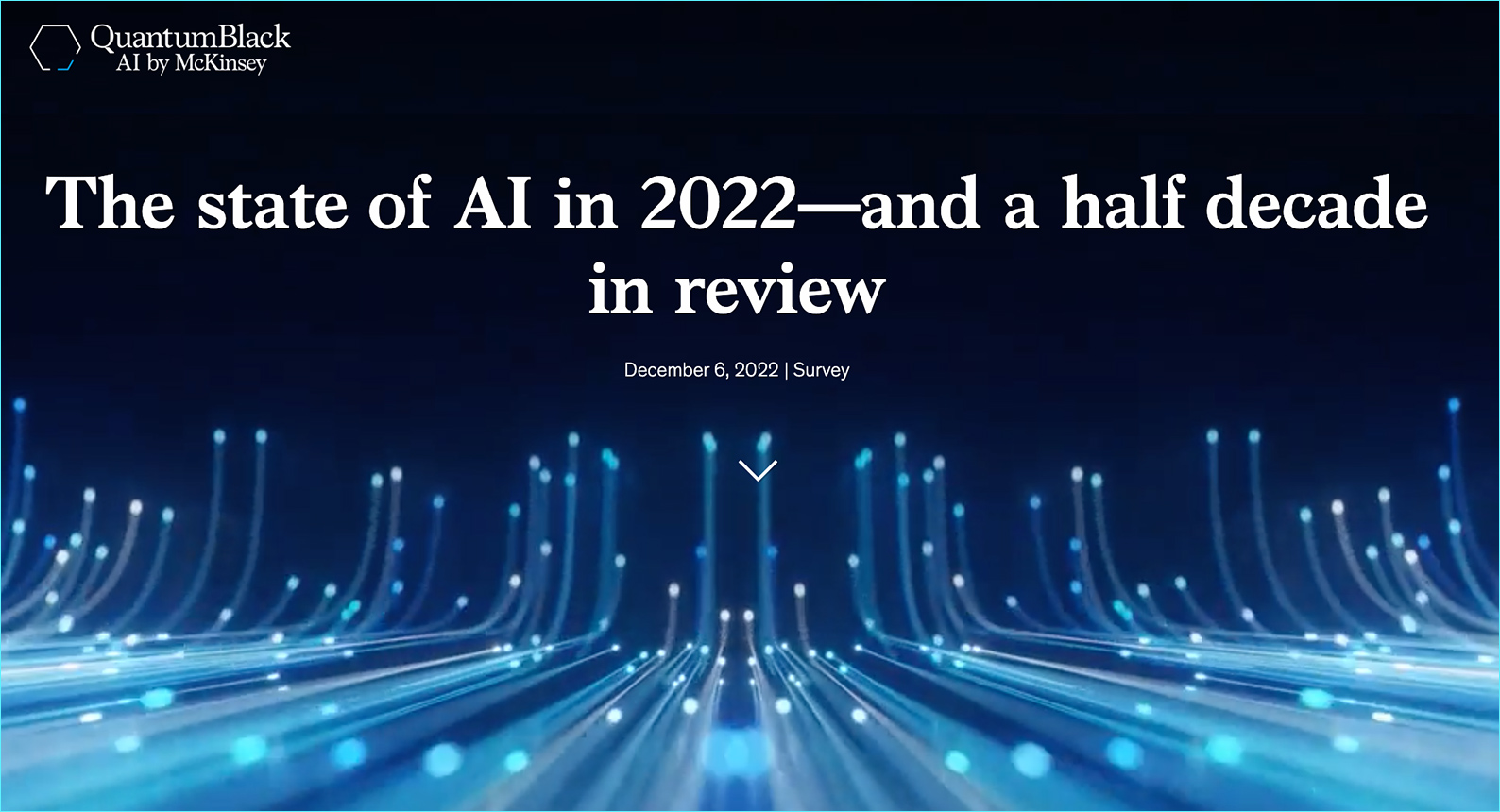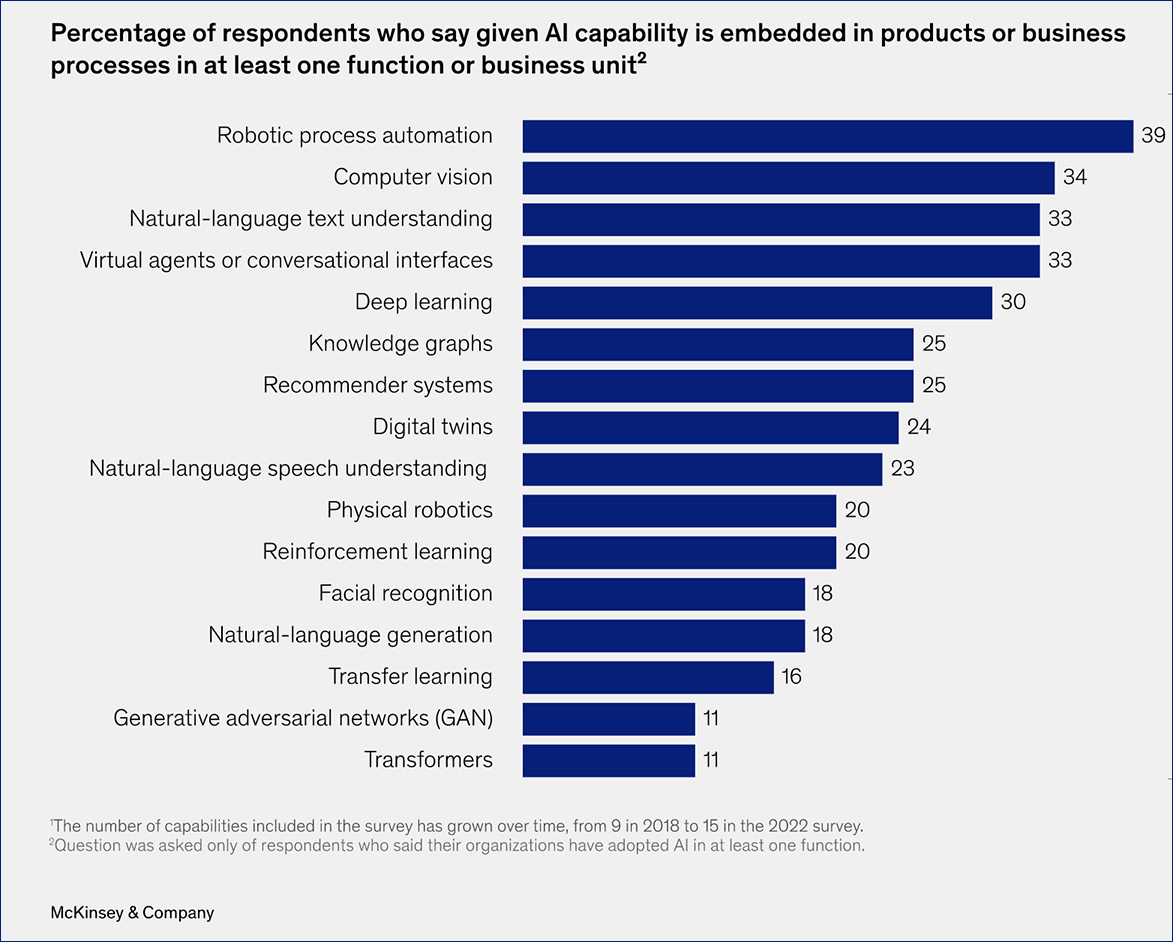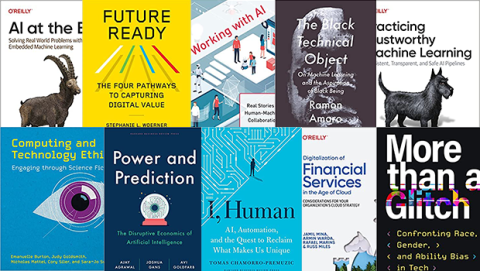The state of AI in 2022—and a half decade in review — from mckinsey.com
The results of this year’s McKinsey Global Survey on AI show the expansion of the technology’s use since we began tracking it five years ago, but with a nuanced picture underneath.
Example graphic:
AI is finally good at stuff, and that’s a problem — from vox.com by Rebecca Heilweil
Here’s why you’ve been hearing so much about ChatGPT.
Excerpt (emphasis DSC):
A few weeks ago, Wharton professor Ethan Mollick told his MBA students to play around with GPT, an artificial intelligence model, and see if the technology could write an essay based on one of the topics discussed in his course. The assignment was, admittedly, mostly a gimmick meant to illustrate the power of the technology. Still, the algorithmically generated essays — although not perfect and a tad over-reliant on the passive voice — were at least reasonable, Mollick recalled. They also passed another critical test: a screening by Turnitin, a popular anti-plagiarism software. AI, it seems, had suddenly gotten pretty good.
It certainly feels that way right now. Over the past week or so, screenshots of conversations with ChatGPT, the newest iteration of the AI model developed by the research firm OpenAI, have gone viral on social media.
From DSC:
I was watching a sermon the other day, and I’m always amazed when the pastor doesn’t need to read their notes (or hardly ever refers to them). And they can still do this in a much longer sermon too. Not me man.
It got me wondering about the idea of having a teleprompter on our future Augmented Reality (AR) glasses and/or on our Virtual Reality (VR) headsets. Or perhaps such functionality will be provided on our mobile devices as well (i.e., our smartphones, tablets, laptops, other) via cloud-based applications.
One could see one’s presentation, sermon, main points for the meeting, what charges are being brought against the defendant, etc. and the system would know to scroll down as you said the words (via Natural Language Processing (NLP)). If you went off script, the system would stop scrolling and you might need to scroll down manually or just begin where you left off.
For that matter, I suppose a faculty member could turn on and off a feed for an AI-based stream of content on where a topic is in the textbook. Or a CEO or University President could get prompted to refer to a particular section of the Strategic Plan. Hmmm…I don’t know…it might be too much cognitive load/overload…I’d have to try it out.
And/or perhaps this is a feature in our future videoconferencing applications.
But I just wanted to throw these ideas out there in case someone wanted to run with one or more of them.
Along these lines, see:
Tell me you’re not going to want a pair of #AR glasses ?
? @TechAmazing #AugmentedReality #Wearables #5G #CES2023 #FutureOfWork #AI #cloud
pic.twitter.com/He5d1bSnQK— Glen Gilmore | ?? #CES2023 (@GlenGilmore) December 3, 2022
.
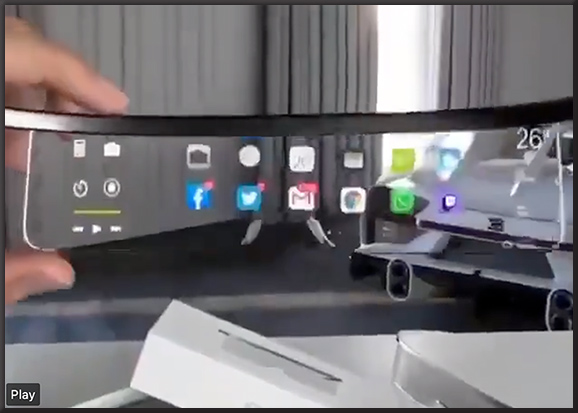
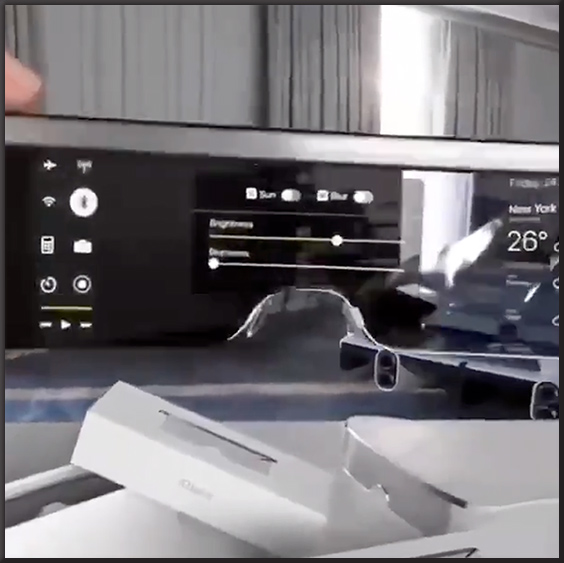
After playing with in for the past 24 hours, I believe #ChatGPT is going to change the world, including the world of law and legal education. Ignore it at your peril. #AI #innovation #legaltech
— Gabe Teninbaum (@GTeninbaum) December 3, 2022
More interesting results from #ChatGPT. I entered the same prompt about a bicycle accident twice — once bracketed by clear messaging that I was looking for legal advice, once without that messaging. Check out the differences. pic.twitter.com/BJJiGjAvs6
— Jordan Furlong (@jordan_law21) December 6, 2022
Example resources:
- Trends in legal technology post-pandemic — by Caroline Boudreau Sweeney
- Trends in Legal technology — by CIOReview
Also see:
In this episode we discuss:
- Some background on our guest Gabe Teninbaum, and why he’s passionate about spaced repetition
- The theory behind spaced repetition and how it works in practice
- Using spaced repetition to memorize material as a law student
- How early in your study should you start using the spaced repetition technique?
- Does learning with spaced repetition as a law student help lay the foundation for bar study?
- How you can use the spacedrepetition.com website for your law school and bar exam studies
Seriously, #ChatGPT is going to change everything about how people gain access to legal information and guidance. Look at this. pic.twitter.com/BkxZlMxB9o
— Jordan Furlong (@jordan_law21) December 2, 2022
Speaking of technology and the law, also see:
Out today! Catch the latest episode of Talk Justice for a look at creative ways to connect people with legal professionals and resources– by bus, kiosks and even a kayak! https://t.co/wApNohRJw3
— Legal Services Corp. (@LSCtweets) November 29, 2022
Holding Court Outside the Courtroom — from legaltalknetwork.com
Host: Molly McDonough, Legal Talk Network Podcast Producer and Founder of Molly McDonough Media, LLC.
Guests:
- Dori Rapaport, Executive Director at Legal Aid Services of Northeastern Minnesota
- David Estep, Supervising Attorney at Legal Aid of West Virginia
- Honorable Jeanne M. Robison, Salt Lake City Justice Court Judge
From DSC:
I’d like to thank Sarah Huibregtse for her post out on LinkedIn where she commented on and referenced the following item from Nicholas Thompson (CEO at The Atlantic):
Also relevant/see:
Also related/see the following item which I thank Sam DeBrule’s Machine Learnings newsletter for:
There’s a certain feeling that happens when a new technology adjusts your thinking about computing. Google did it. Firefox did it. AWS did it. iPhone did it. OpenAI is doing it with ChatGPT.
— Aaron Levie (@levie) December 4, 2022
Also, somewhat related, see the following item that Julie Johnston mentioned out on LinkedIn:
Top 10 conversational AI trends for 2023 — from linkedin.com by Kane Simms and Tim Holve, Tarren Corbett-Drummond, Arte Merritt, and Kevin Fredrick.
Excerpt:
In 2023, businesses will realise that, in order to get out of FAQ Land, they need to synchronise business systems together to deliver personalised transactional experiences for customers.
“We finally have the technologies to do all the things we imagined 10 years ago.”
The Top 10 Digital Health Stories Of 2022 — from medicalfuturist.com by Dr. Bertalan Mesko
Excerpt:
Edging towards the end of the year, it is time for a summary of how digital health progressed in 2022. It is easy to get lost in the noise – I myself shared well over a thousand articles, studies and news items between January and the end of November 2022. Thus, just like in 2021, 2020 (and so on), I picked the 10 topics I believe will have the most significance in the future of healthcare.
9. Smart TVs Becoming A Remote Care Platform
The concept of turning one’s TV into a remote care hub isn’t new. Back in 2012, researchers designed a remote health assistance system for the elderly to use through a TV set. But we are exploring this idea now as a major tech company has recently pushed for telehealth through TVs. In early 2022, electronics giant LG announced that its smart TVs will be equipped with the remote health platform Independa.And in just a few months (late November) came a follow-up: a product called Carepoint TV Kit 200L, in beta testing now. Powered by Amwell’s Converge platform, the product is aimed at helping clinicians more easily engage with patients amid healthcare’s workforce shortage crisis.
Also relevant/see:
Asynchronous Telemedicine Is Coming And Here Is Why It’s The Future Of Remote Care — from medicalfuturist.com by Dr. Bertalan Mesko
Excerpt:
Asynchronous telemedicine is one of those terms we will need to get used to in the coming years. Although it may sound alien, chances are you have been using some form of it for a while.
With the progress of digital health, especially due to the pandemic’s impact, remote care has become a popular approach in the healthcare setting. It can come in two forms: synchronous telemedicine and asynchronous telemedicine.
How High School Should Change for an Era of AI and Robots — from edsurge.com by Jeffrey R. Young
Excerpt:
In other words, we have for the last century and a half in the knowledge economy been educating our students to become repositories of information—whether they’re lawyers or doctors [or engineers] and so forth. And then somebody pays them a great deal of money to extract some of that knowledge from their heads. What’s happening now is that’s being reposited in algorithms increasingly, and that’s only going to be more the case going forward, so that the most intelligent, capable medical diagnostician, I predict, will be a computer somewhere in the next 20 years.
What is the role of the doctor then? The doctor’s role is to be a knowledgeable interpreter of that algorithmic diagnosis—to check it, to make sure that there wasn’t a snafu, and to make sure that there is no social bias in the outcome. And also to help interpret that into a regimen for treatment and healing on the part of the patient in a human-connected, empathic way.
And [at Iowa Big], one of the very first questions that one of her teachers asked her was, ‘What makes you mad?’
…
The systems that we have for public education are becoming more rigidified, not more experimental and resilient. And they’re becoming increasingly non-functional. And I believe they’re going to face some sort of systemic collapse.
And here are several other items from the education space:
All Teacher Shortages Are Local, New Research Finds — from the74million.org by Kevin Mahnken
In a study released [on 12/1/22], researchers show that teacher vacancy levels vary drastically between schools in the same communities
Excerpt:
K-12 teacher shortages — one of the most disputed questions in education policy today — are an undeniable reality in some communities, a newly released study indicates. But they are also a hyper-local phenomenon, the authors write, with fully staffed schools existing in close proximity to those that struggle to hire and retain teachers.
The paper, circulated Thursday through Brown University’s Annenberg Institute for School Reform, uses a combination of survey responses and statewide administrative records from Tennessee to create a framework for identifying how and where teacher shortages emerge.
Why Are Americans Fleeing Public Schools? — from washingtonpost.com by John D. Harden and Steven Johnson
Seven parents on choosing private education for their kids
Excerpt:
The pandemic transformed the landscape of K-12 education. Some parents withdrew their kids from public school and placed them into private or home schools. Their reasons varied: Many preferred private schools that offered in-person instruction; others distrusted public schools’ pandemic precautions.
It’s not clear whether those trends will stick, and the factors are complex. So far, data show that since 2019, private enrollment is up, public enrollment is down and home schooling has become more popular. Families flocked to private and home schools at the greatest rate in a decade, according to American Community Survey estimates from the U.S. Census. The government projects that K-12 public school enrollment — already facing demographic pressures — will drop further to about 46 million students by fall 2030, according to the National Center for Education Statistics, reversing decades of growth.
Education is key to tackle prevalent challenges. I’m excited to join the European Education Summit in Brussels today to share insight on future-proofing our education systems. #EduSummitEU pic.twitter.com/4H9ZO45HT9
— Eva Keiffenheim (@Evti) December 1, 2022
Mississippi microschools are expanding education options for families — from spn.org by Kerry McDonald
Excerpt:
When Stephanie Harper decided to open Harper Learning Academy in Byram, Mississippi in August, her goal was to create a small, personalized educational setting in which her daughter would thrive. Conventional classroom environments weren’t a good match for Harper’s child. They also weren’t working well for the daughter of Harper’s colleague, Tekeeta Funchess. Harper and Funchess had been longtime teachers in the Jackson Public Schools before they left their jobs to provide educational consulting services to public school districts through the firm Harper founded in 2016.
As they worked together, they realized their daughters were experiencing similar challenges in standard school settings. “We’re mothers with children who learn differently who are trying to improve the system but realized that the system wasn’t working for our children,” said Harper, who is a certified teacher with a Ph.D. in education. They also suspected it wasn’t working for many other children as well.
10 Must Read Books for Learning Designers — from linkedin.com by Amit Garg
Excerpt:
From the 45+ #books that I’ve read in last 2 years here are my top 10 recommendations for #learningdesigners or anyone in #learninganddevelopment
Speaking of recommended books (but from a more technical perspective this time), also see:
10 must-read tech books for 2023 — from enterprisersproject.com by Katie Sanders (Editorial Team)
Get new thinking on the technologies of tomorrow – from AI to cloud and edge – and the related challenges for leaders
A bot that watched 70,000 hours of Minecraft could unlock AI’s next big thing — from technologyreview.com by Will Douglas Heaven
Online videos are a vast and untapped source of training data—and OpenAI says it has a new way to use it.
Excerpt:
OpenAI has built the best Minecraft-playing bot yet by making it watch 70,000 hours of video of people playing the popular computer game. It showcases a powerful new technique that could be used to train machines to carry out a wide range of tasks by binging on sites like YouTube, a vast and untapped source of training data.
The Minecraft AI learned to perform complicated sequences of keyboard and mouse clicks to complete tasks in the game, such as chopping down trees and crafting tools. It’s the first bot that can craft so-called diamond tools, a task that typically takes good human players 20 minutes of high-speed clicking—or around 24,000 actions.
The result is a breakthrough for a technique known as imitation learning, in which neural networks are trained to perform tasks by watching humans do them.
…
The team’s approach, called Video Pre-Training (VPT), gets around the bottleneck in imitation learning by training another neural network to label videos automatically.
Speak lands investment from OpenAI to expand its language learning platform — from techcrunch.com by Kyle Wiggers
Excerpts:
“Most language learning software can help with the beginning part of learning basic vocabulary and grammar, but gaining any degree of fluency requires speaking out loud in an interactive environment,” Zwick told TechCrunch in an email interview. “To date, the only way people can get that sort of practice is through human tutors, which can also be expensive, difficult and intimidating.”
Speak’s solution is a collection of interactive speaking experiences that allow learners to practice conversing in English. Through the platform, users can hold open-ended conversations with an “AI tutor” on a range of topics while receiving feedback on their pronunciation, grammar and vocabulary.
It’s one of the top education apps in Korea on the iOS App Store, with over 15 million lessons started annually, 100,000 active subscribers and “double-digit million” annual recurring revenue.
If you last checked in on AI image makers a month ago & thought “that is a fun toy, but is far from useful…” Well, in just the last week or so two of the major AI systems updated.
You can now generate a solid image in one try. For example, “otter on a plane using wifi” 1st try: pic.twitter.com/DhiYeVMEEV
— Ethan Mollick (@emollick) November 26, 2022
Is AI Generated Art Really Coming for Your Job? — from edugeekjournal.com by Matt Crosslin
Excerpt:
So, is this a cool development that will become a fun tool for many of us to play around with in the future? Sure. Will people use this in their work? Possibly. Will it disrupt artists across the board? Unlikely. There might be a few places where really generic artwork is the norm and the people that were paid very little to crank them out will be paid very little to input prompts. Look, PhotoShop and asset libraries made creating company logos very, very easy a long time ago. But people still don’t want to take the 30 minutes it takes to put one together, because thinking through all the options is not their thing. You still have to think through those options to enter an AI prompt. And people just want to leave that part to the artists. The same thing was true about the printing press. Hundreds of years of innovation has taught us that the hard part of the creation of art is the human coming up with the ideas, not the tools that create the art.
A quick comment from DSC:
Possibly, at least in some cases. But I’ve seen enough home-grown, poorly-designed graphics and logos to make me wonder if that will be the case.
How to Teach With Deep Fake Technology — from techlearning.com by Erik Ofgang
Despite the scary headlines, deep fake technology can be a powerful teaching tool
Excerpt:
The very concept of teaching with deep fake technology may be unsettling to some. After all, deep fake technology, which utilizes AI and machine learning and can alter videos and animate photographs in a manner that appears realistic, has frequently been covered in a negative light. The technology can be used to violate privacy and create fake videos of real people.
However, while these potential abuses of the technology are real and concerning that doesn’t mean we should turn a blind eye to the technology’s potential when using it responsibly, says Jaime Donally, a well-known immersive learning expert.
From DSC:
I’m still not sure about this one…but I’ll try to be open to the possibilities here.
Educators Are Taking Action in AI Education to Make Future-Ready Communities — from edsurge.com by Annie Ning
Excerpt:
AI Explorations and Their Practical Use in School Environments is an ISTE initiative funded by General Motors. The program provides professional learning opportunities for educators, with the goal of preparing all students for careers with AI.
Recently, we spoke with three more participants of the AI Explorations program to learn about its ongoing impact in K-12 classrooms. Here, they share how the program is helping their districts implement AI curriculum with an eye toward equity in the classroom.
Stealth Legal AI Startup Harvey Raises $5M in Round Led By OpenAI — from lawnext.com by Bob Ambrogi
Excerpt (emphasis DSC):
A hitherto stealth legal AI startup emerged from the shadows today with news via TechCrunch that it has raised $5 million in funding led by the startup fund of OpenAI, the company that developed advanced neural network AI systems such as GPT-3 and DALL-E 2.
The startup, called Harvey, will build on the GPT-3 technology to enable lawyers to create legal documents or perform legal research by providing simple instructions using natural language.
The company was founded by Winston Weinberg, formerly an associate at law firm O’Melveny & Myers, and Gabriel Pereyra, formerly a research scientist at DeepMind and most recently a machine learning engineer at Meta AI.
This Copyright Lawsuit Could Shape the Future of Generative AI — from wired.com by Will Knight
Algorithms that create art, text, and code are spreading fast—but legal challenges could throw a wrench in the works.
Excerpts:
A class-action lawsuit filed in a federal court in California this month takes aim at GitHub Copilot, a powerful tool that automatically writes working code when a programmer starts typing. The coder behind the suit argues that GitHub is infringing copyright because it does not provide attribution when Copilot reproduces open-source code covered by a license requiring it.
…
Programmers have, of course, always studied, learned from, and copied each other’s code. But not everyone is sure it is fair for AI to do the same, especially if AI can then churn out tons of valuable code itself, without respecting the source material’s license requirements. “As a technologist, I’m a huge fan of AI ,” Butterick says. “I’m looking forward to all the possibilities of these tools. But they have to be fair to everybody.”
Whatever the outcome of the Copilot case, Villa says it could shape the destiny of other areas of generative AI. If the outcome of the Copilot case hinges on how similar AI-generated code is to its training material, there could be implications for systems that reproduce images or music that matches the style of material in their training data.
Also legal-related, see:
- Columbia, Georgetown and Stanford Law Schools Quit ‘U.S. News’ — from insidehighered.com by Scott Jaschik
Also related to AI and art/creativity from Wired.com, see:
- Picture Limitless Creativity at Your Fingertips — by Kevin Kelly
Artificial intelligence can now make better art than most humans. Soon, these engines of wow will transform how we design just about everything. - This Uncensored AI Art Tool Can Generate Fantasies—and Nightmares — by Will Knight
Open source project Stable Diffusion allows anyone to conjure images with algorithms, but some fear it will be used to create unethical horrors. - Who Will Own the Art of the Future? — by Jessica Rizzo
OpenAI has announced that it’s granting Dall-E users the right to commercialize their art. For now.
2022 Winners of the LegalTech Breakthrough Awards — from legaltechbreakthrough.com
Categories include:
- Case Management
- Client Relations
- Data & Analytics
- Documentation
- Legal Education
- Practice Management
- Legal Entity Management
- Legal Research
- Online Dispute Resolution
- Contract Management
- eDiscovery
- Marketplaces
- RegTech
- Leadership
Also see:
- Soaring Travel Costs Put Lawyers Back on Zoom –– from kift.com Matthew Parsons
Rising airfares and travel costs are prompting legal professionals involved in dispute resolutions to return to video conferencing. - Global Dispute Resolution: The Future of Virtual Legal Proceedings Is Shaped by Soaring Travel Costs — from matlawreview.com
With the cost of international air travel rising sharply, remote hearings are a practical alternative to in-person proceedings. International travel is expensive, and the virtual option means that it is no longer necessary to count travel as a “cost of doing business” when pursuing an international dispute. The widespread use of technology in global dispute resolution proceedings gives attorneys and their clients the option to participate remotely, which is a compelling cost saver for all parties.
- Most debt lawsuits get decided without a fight. Michigan leaders want to change the rules. — from mlive.com by Matthew Miller
Excerpt:
Most of the 1.9 million debt collection cases filed in Michigan’s district courts over the past decade or so never went to trial. Usually, the defendants don’t show up to court, and debt collectors win by default, according to data compiled by the Michigan Justice for All Commission. In most cases, the courts end up garnishing defendants’ wages, income tax returns or other assets, sometimes on the basis of complaints that include little more than the name of the creditor, an account number and the balance due.
And both debt lawsuits and garnishment are more common for people living in primarily Black neighborhoods, regardless of their income.
Members of the Commission say Michigan’s rules around debt collection lawsuits don’t do enough to protect regular people, who sometimes don’t find out they’ve been sued until they see money coming out of their paychecks.
They say those rules need to change.
- World-first virtual legal clinic opens for business across BC, aiming to increase affordability, diversity and reach of legal professionals — from finance.yahoo.com by Access Pro Bono
An early participant in the Law Society of BC’s Innovation Sandbox, the Clinic offers the in-person and virtual help of 25 articling students located in 15 different BC communities —from Tofino to Cranbrook— with the support of 15 supervising lawyers, four staff and dozens of local mentors. Together, they provide fixed-fee services in a wide range of areas covering everyday legal problems.
Stephen Downes’ reflection on “Every Student Needs a Learning Coach” — from by Nate McClennen
Excerpt (from Stephen):
The key to making this happen, I think, is to reorganize local schooling to take advantage of online (and increasingly, AI-generated) learning services, allowing in-person educators to adopt this coaching function.
Key points from Nate’s article:
- As learning becomes more personalized, learning opportunities expanded and unbounded, and learning science research more robust, an updated and revised advisory role is more important than ever.
- Redefining the coaching/mentor/advisor role as the educational landscape shifts is critical to ensure success for every learner.
Also relevant to using AI in education/see:
NVIDIA Teams With Microsoft to Build Massive Cloud AI Computer — from nvidianews.nvidia.com
Tens of Thousands of NVIDIA GPUs, NVIDIA Quantum-2 InfiniBand and Full Stack of NVIDIA AI Software Coming to Azure; NVIDIA, Microsoft and Global Enterprises to Use Platform for Rapid, Cost-Effective AI Development and Deployment
Excerpt:
NVIDIA announced [on 11/16/22] a multi-year collaboration with Microsoft to build one of the most powerful AI supercomputers in the world, powered by Microsoft Azure’s advanced supercomputing infrastructure combined with NVIDIA GPUs, networking and full stack of AI software to help enterprises train, deploy and scale AI, including large, state-of-the-art models.
Addendum on 11/20/22:
- IBM unveils its 433 qubit Osprey quantum computer— from techcrunch.com by Frederic Lardinois









